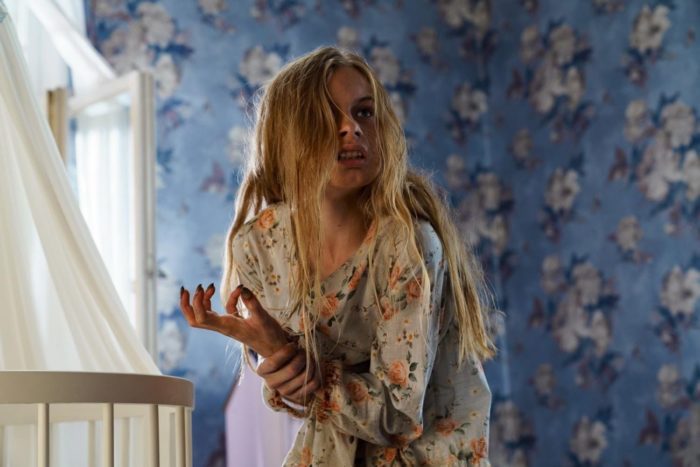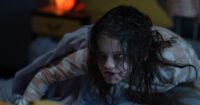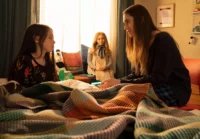I love movies that explore the darkness dwelling inside seemingly good people. Films like Blue Velvet, Dr. Jekyll and Mr. Hyde, and just about every werewolf movie ever made hit a thematic sweet spot that I find irresistible, so naturally, Hatching was one of my favorite films of 2022. It’s a Finnish monster movie about a girl named Tinja who finds an egg in the woods and brings it home with her, and from there, the story goes in all sorts of weird directions.
For starters, the egg soon begins to grow, and it quickly reaches an enormous size. Then, when it finally hatches, a skeletal, bird-like creature emerges, and the girl has to care for the monster while keeping it a secret from her family. That’s just the tip of this bizarre iceberg, but even if you don’t know anything else about Hatching, I’m sure you can already figure out why I love it so much.
The monster is a clear metaphor for the darkness that dwells inside Tinja (and, as we’ll come to see, her family as well), so it’s right in my thematic wheelhouse. In fact, I think Hatching hits that note better than most other movies, so let’s dive into this fantastic film and see exactly how it conveys its timeless message.
The Opening Scene

Hatching wastes no time letting us know what it’s really about. Tinja’s mother runs a popular blog that purports to show the daily life of a typical Finnish family, and the movie opens with her recording a video for it. She captures her family looking and acting happy as can be, and the cinematography and music both contribute to the atmosphere of domestic bliss.
But we very quickly learn that this is just a facade. Right as the woman is getting ready to end the recording, the family hears a loud bang. Tinja opens a window to see what happened, and immediately, a crow rushes into the house and starts flying around the living room, predictably causing a whole bunch of mayhem and destruction.
Tinja eventually manages to capture the bird, but before she can let it back outside, her mother tells her to bring it over to her. Tinja obliges, and when she gives the crow to her mother, the woman does something shocking. She grabs the poor bird’s head and snaps its neck, and then she tells Tinja to throw it out.
The first time I saw this scene, I was horrified. That bird didn’t deserve to die, so there was absolutely no reason for Tinja’s mother to kill it. She obviously just does it out of spite, because the crow had the audacity to disrupt her family’s perfect life and their perfectly decorated living room, and that lets us know without a doubt that this woman is a fraud.
She wants people to think she lives a beautiful life full of love and happiness, but it’s all a lie. She’s actually a selfish, callous woman who only cares about appearances, and she’s apparently willing to hurt anyone or anything that gets in her way. In a word, the ugliness inside her heart matches the beauty of the blissful facade she presents to the world, so even after just one scene, it’s easy to see that Hatching is all about the darkness that lurks inside seemingly good people.
A Monstrous Metaphor

We could spend hours going over all the different ways Hatching hammers home just how heartless and uncaring Tinja’s mother really is, but if you watch the movie, you won’t have any trouble seeing it. It’s impossible to miss, so we don’t have to point it out here. Instead, I want to talk about something a bit more interesting: the monster.
Like I said before, the bird monster that Tinja has to hide from her family is obviously a metaphor for the hidden darkness and ugliness that lurks inside people like her mother, but that’s just the beginning. As Hatching goes on, the metaphor becomes more and more precise, so let’s turn to it and examine exactly how this creature embodies the film’s main theme.
For starters, this monster continually attacks people and things Tinja has negative feelings towards. To take just a couple of examples, it kills a dog that keeps Tinja up one night with its barking, and it also attacks a girl who wins a spot at a gymnastics competition over her.
Granted, Tinja never expresses any sort of ill will towards the dog or her fellow gymnast, and I don’t think she would ever try to hurt them herself. But she apparently has some dark feelings about them, and the monster simply acts those feelings out. Tinja is angry at the dog for not letting her sleep, and she’s envious of the girl who won a competition spot over her, and the bird creature takes those sentiments as its marching orders.
So when Tinja hides this thing from her family, it doesn’t just function as an arbitrary symbol of the darkness inside her. Rather, it literally acts out her dark thoughts and impulses, so it does more than just represent her baser nature. It embodies that side of her, and in a very real sense, it is that darkness.
The Monster Is Tinja

If that were the extent of the monstrous metaphor in this story, it would be enough to make the movie’s point, but Hatching doesn’t stop there. As the film progresses, the monster slowly changes its appearance, and that takes the metaphor one step further.
At first, we can see that the creature is undergoing some sort of transformation, but it’s not clear what it’s going to become. In fact, this change makes it look even more bizarre, so we can’t help but wonder where this is all headed. Then, as the film goes on, the answer soon becomes clear: the monster is turning into a replica of Tinja. In fact, it eventually becomes so similar to the girl that a few characters mistake it for her, and at the end of Hatching, the thing completes its metamorphosis.
In the final scene, Tinja’s mother accidentally stabs her, and the creature drinks a bit of her blood as she dies. This kicks off the final phase of its transformation, and when it finally looks exactly like Tinja, it turns to Tinja’s mother and croaks the word “mother.”
With that ending, Hatching essentially reveals itself to be the inverse of a werewolf movie. In werewolf films, the person becomes the monster, but this time, the monster has become the person. Either way though, the point is the same. We all have a dark side, a monstrous alter ego we have to hide from the rest of the world, and no matter how much we try to distance ourselves from it, we can’t deny that it’s truly part of us.
Why The Monster Matters

That’s the basic message of Hatching, but like many great films, there’s more to it than just a general point about human nature. It also applies that general point in a more specific way, and to see how it does that, we have to circle back to where we began. While the monster primarily represents the darkness within Tinja, it also points us back to her mother.
Remember, Tinja’s mother is a seemingly good person with a hidden dark side too, so everything we can say about Tinja in this regard applies to her as well. More specifically, this woman runs a popular blog that purportedly shows the daily life of a happy and loving Finnish family, but that’s just a facade. In truth, she and her family are all sorts of messed up, and the way I see it, that’s the ultimate message of Hatching.
It’s telling us that we should be very skeptical of celebrities and internet personalities who seem to lead perfect, fairytale lives. Sure, their lives may look flawless from our outside perspectives, but the truth is much more mundane. Everybody’s life has a dark side, no matter how much they may try to hide it, and famous people are no different.
They simply show the world a sugar-coated fantasy version of their lives, so if you ever find yourself getting a bit depressed because your life isn’t as perfect as theirs, remember the message of Hatching. While stars and influencers don’t literally harbor secret bird monsters, the truth is that they’re just as messed up as the rest of us.



